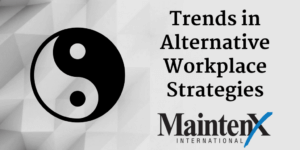
More and more workplaces are adapting to the needs of an increasingly young work force. Is the cubicle out as the flexible, open office comes in? Let’s explore some of the current trends in the changing workplace environment
The Reimagined Workspace
Non-traditional settings and practices are becoming increasingly common as businesses are changing to more informal workplace practices, policies, and structures.
The Flexible Office
The flexible office environment is on the rise, and it’s in response to the fact that a younger generation is flooding the workforce: Generation Z. These younger employees are digital natives, and that’s changed the structure of the businesses who employ them.
From transportation to food to real estate, this new class of professionals works best in alternative workspace environments, and on more flexible schedules.
The World is the New Office
Professionals the world over are working outside their physical workplace—if they even have one—and increasingly that’s also changing. For a lot of businesses this transition is difficult, as many older employees are used to the more traditional workplace. These growing pains aren’t always bad for a company’s bottom line. A reduced need for physical office space means lower rent and maintenance costs.
The workplace is always changing, and this current trend is a prime example of that fact. Companies that are the most successful are those that pay attention to these changes and adapt accordingly. If businesses want to attract the best and brightest of Generation Z, they’d be smart to take note of these growing trends. Generation Z is the biggest in the world, and if workplaces don’t take note, they’ll miss a big opportunity.

